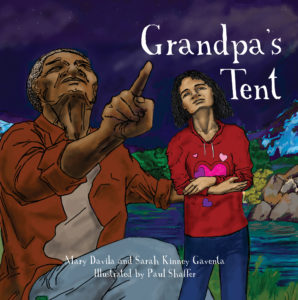 Sarah K. Gaventa and Mary Davila are Episcopal priests, mothers, and authors of Grandpa’s Tent, the newest Forward Movement publication. This story gently and honestly explains death and grieving to children and is perfect for emerging readers and for adults and children to read together. Here is what Sarah and Mary have to say about Grandpa’s Tent.
Sarah K. Gaventa and Mary Davila are Episcopal priests, mothers, and authors of Grandpa’s Tent, the newest Forward Movement publication. This story gently and honestly explains death and grieving to children and is perfect for emerging readers and for adults and children to read together. Here is what Sarah and Mary have to say about Grandpa’s Tent.
How did the idea for this book form and develop?
Mary: Having served as parish priests, Sarah and I were aware of what seemed like a lack of resources to recommend to folks when they asked for children’s books about death and heaven. Many books dealt (beautifully) with death but not heaven; some painted a picture of heaven, but the theology didn’t resonate. We thought, “If it doesn’t exist, let’s create it!”
What was the writing process like?
Mary: Scripture gave us the key image from the very start: Paul’s description of the body as a tent (2 Corinthians 5:1-10). The story was crafted around that…camping, tents, heaven as a permanent home. When Scripture provides such rich metaphors, the writing process is much easier, because the launching point is already there. Sarah and I reached out to fellow clergy of various denominations, asking what material they would like to see addressed in a book. We also met with groups of children, inviting their questions. The writing process itself was less laborious than researching, asking questions, and studying Scripture.
 What was your favorite part of writing Grandpa’s Tent?
What was your favorite part of writing Grandpa’s Tent?
Sarah: My favorite part of writing Grandpa’s Tent was FaceTiming with Mary while we collaborated on our Google Doc. I was so grateful for the technologies that made it possible to work together, even though we were hundreds of miles apart. It was a great way to stay connected with an old friend.
What was the most difficult part?
Sarah: The most difficult part was narrowing in on how best to express resurrection theology to small children. There are so many different images used in the Bible and we had to balance communicating in simple language with the complex ideas found in the Bible about life after death.
Where do you typically write?
Mary: Sarah and I did all of our writing via Skype. She lives in Austin, Texas, and I live in Raleigh, North Carolina. Using a Google document, we wrote on the spot, while we Skyped. I wrote in my kitchen on my days off while my children were at school.
Where would you go for inspiration?
Mary: Scripture and people—those are my sources of inspiration. I went through seasons of feeling convicted to write the book, and then other times, it fell to the back burner. But when someone in the parish died, or a child lost a grandparent or friend, and I was asked for a resource, I’d think, “We really could write something that seeks to affirm what we do know about life and death, and yet upholds the mystery of life after death.” I also felt like Sarah and I could be both direct and comforting in addressing some very practical things, from a feeling of discomfort with the smells and sights within assisted living facilities, to what to expect in attending a wake, funeral service, and burial. To be direct about the practical, and yet expansive and generous about the mystery of it all, was a balance we tried to strike.
How do you see this book being utilized?
 Sarah: We created Grandpa’s Tent as a resource for children who were dealing with grief–and for pastors teaching children about death in general. In the early part of our priesthood, Mary and I both were responsible for children’s formation and we share a philosophy of really listening to children and addressing their deep concerns. Many children worry about death, even if they are not actively grieving. We wanted to give parents, pastors, and hospitals a resource for beginning a conversation about this difficult topic.
Sarah: We created Grandpa’s Tent as a resource for children who were dealing with grief–and for pastors teaching children about death in general. In the early part of our priesthood, Mary and I both were responsible for children’s formation and we share a philosophy of really listening to children and addressing their deep concerns. Many children worry about death, even if they are not actively grieving. We wanted to give parents, pastors, and hospitals a resource for beginning a conversation about this difficult topic.
Is there anything else you’d like to share with readers?
Mary: This book deals with topics that most people would really rather not talk about. People feel afraid to bring up the subject of death, and they don’t feel equipped to answer children’s questions. If this book brings comfort to even one family as they journey through death and grief, then our work has been fruitful.



